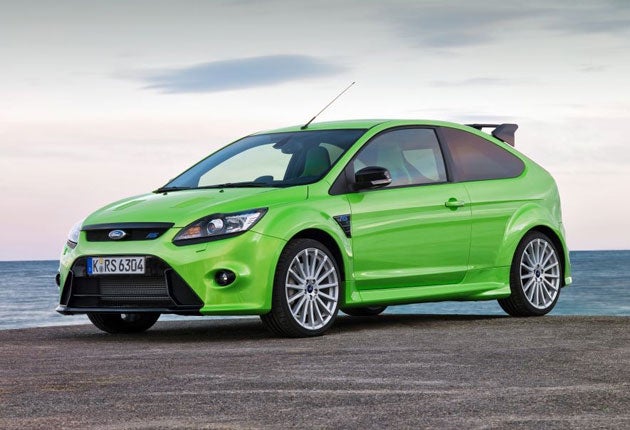Ford Focus RS
Ford's new Focus RS is the ultimate hot hatch, and it has eco credentials too

Your support helps us to tell the story
From reproductive rights to climate change to Big Tech, The Independent is on the ground when the story is developing. Whether it's investigating the financials of Elon Musk's pro-Trump PAC or producing our latest documentary, 'The A Word', which shines a light on the American women fighting for reproductive rights, we know how important it is to parse out the facts from the messaging.
At such a critical moment in US history, we need reporters on the ground. Your donation allows us to keep sending journalists to speak to both sides of the story.
The Independent is trusted by Americans across the entire political spectrum. And unlike many other quality news outlets, we choose not to lock Americans out of our reporting and analysis with paywalls. We believe quality journalism should be available to everyone, paid for by those who can afford it.
Your support makes all the difference.About time we featured a truly green car. Well, they come no more luridly green than the new Ford Focus RS, whose Ultimate Green shade can be spotted from several miles away.
"Ultimate" relates to the BP/Castrol promotional link that Ford has forged for its World Rally team, but it's appropriate because there has never been a faster, more fearsome Focus this side of a rally stage. The petrolheads have been predicting its arrival for ages. Would it be four-wheel drive? Four cylinders? Hopelessly expensive? Encouragingly affordable?
The previous Focus RS had a long, mysterious gestation too. It arrived late, was expensive to make because each one had to be built "offline" by a specialist team, and it gained a reputation not just for pace but also for sniffing out the hedgerows when accelerating hard on an uneven road. The Quaife limited-slip differential took part of the blame.
This time, reckoned Ford's RS supremo Jost Capito, the RS would be better behaved. No slower, mind; quite the opposite. Cars such as a Mitsubishi Evo or a Subaru Impreza STi, the stuff of a certain type of petrolhead's dreams if not quite mine, have four-wheel drive like a World Rally car, but Capito thought this a bad idea. "We shall make 305bhp [for that is the RS's extraordinary output from its 2.5 litres and five turbocharged cylinders] work with front-wheel drive, or there will be no Focus RS."
That goes counter to many engineers' instincts, but Jost Capito's reasoning is admirable. The first RS prototypes were indeed four-wheel drive, but they lacked the edgy, agile feel Capito wanted, and they weighed too much. He thinks the messages a powerful front-wheel-drive car sends through its steering wheel, far from being a corruption of directional purity, help you to feel the power and the grip. The trick is not to let that spill over into that tugging and fighting that blighted the first Focus RS.
So it's RevoKnuckle to the rescue. This is not a big-fisted superhero from Marvel Comics but a clever front suspension system in which the steerable hub is separated from the suspension strut, which itself no longer turns. Similar to, but more sophisticated than, the system in the Renaultsport Mégane, it ensures the engine's considerable torque – 325lb ft all the way from 2,300 to 4,500rpm – doesn't try to pull the front wheels in unwanted directions when grip is uneven.
Does it work? Will the RS drive as it looks? Central to those looks is a body widened, compared with the Focus ST starting point, to cover the broader stance. Many of the exterior panels are unique to the RS, although this time the fastest Focus is built on the same lines as its humbler relatives. There's a huge version of Ford's now-usual trapezoidal front air intake, air-louvres on the bonnet, wide sills and wheel arches, and a rather obvious, gloss-black rear spoiler, all of it aerodynamically vital.
Inside, Recaro racing-style seats clamp you firmly in place and there's much faux-carbon fibre. The scene is set. Starter button pressed, hear a deeper, harder version of the ST's five-cylinder harmonic hum. Straight away the RS feels mightily energetic, pouring torque on to the road with the help of its enlarged turbocharger and doubled boost pressure. A big turbo can dull the accelerator response at low speeds, but not here.
You can work the engine up to 7,050rpm, at which point the hefty pair of tailpipes emits a stirring howl, but there's little point. The RS works best if you keep it in that wide band of maximum torque, hauling through bends in one gear higher than you expected, enjoying the pops and crackles each time you lift the accelerator.
One reason you can stay in a higher gear is that you'll be cornering faster than you initially dreamed possible. The RS flicks into a corner with perfect precision, its quick, meaty steering telling exactly what is happening under the wide tyres. Then you can apply the power earlier than you would expect, and feel the latest version of that clever Quaife differential haul the nose to the bend's exit as the thrust erupts. It's an extraordinary, almost addictive sensation, achieved without electronic help and all the purer for it.
This is a proper enthusiast's car, in proper touch with the road. Yet it rides tidily over bumps, and its steering tugs at your hands under hard acceleration only enough to hint at the forces at your control. Meet today's ultimate hot hatchback, for £24,995. And at 225g/km CO2, it's even green of its type. As you can see.
Join our commenting forum
Join thought-provoking conversations, follow other Independent readers and see their replies
Comments